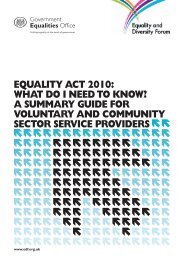Equality Act 2010: Public Sector Equality Duty what do I need to know?
Equality Act 2010: Public Sector Equality Duty what do I need to know?
Equality Act 2010: Public Sector Equality Duty what do I need to know?
- No tags were found...
You also want an ePaper? Increase the reach of your titles
YUMPU automatically turns print PDFs into web optimized ePapers that Google loves.
The <strong>Equality</strong> <strong>Duty</strong>The <strong>Equality</strong> <strong>Duty</strong> has three aims. It requires publicbodies <strong>to</strong> have due regard <strong>to</strong> the <strong>need</strong> <strong>to</strong>:• eliminate unlawful discrimination,harassment, victimisation and any other conductprohibited by the <strong>Act</strong>;• advance equality of opportunity betweenpeople who share a protected characteristic andpeople who <strong>do</strong> not share it; and• foster good relations between people whoshare a protected characteristic and people who<strong>do</strong> not share it.Having due regard means consciously thinkingabout the three aims of the <strong>Equality</strong> <strong>Duty</strong> as par<strong>to</strong>f the process of decision-making. This means thatconsideration of equality issues must influence thedecisions reached by public bodies – such as in howthey act as employers; how they develop, evaluateand review policy; how they design, deliver andevaluate services, and how they commission andprocure from others.Having due regard <strong>to</strong> the <strong>need</strong> <strong>to</strong> advanceequality of opportunity involves considering the<strong>need</strong> <strong>to</strong>:• remove or minimise disadvantages suffered bypeople due <strong>to</strong> their protected characteristics;• meet the <strong>need</strong>s of people with protectedcharacteristics; and• encourage people with protected characteristics<strong>to</strong> participate in public life or in other activitieswhere their participation is low.Fostering good relations involves tacklingprejudice and promoting understanding betweenpeople who share a protected characteristic an<strong>do</strong>thers.Complying with the <strong>Equality</strong> <strong>Duty</strong> may involvetreating some people better than others, as far asthis is allowed by discrimination law. For example,it may involve making use of an exception or thepositive action provisions in order <strong>to</strong> provide aservice in a way which is appropriate for people whoshare a protected characteristic – such as providingcomputer training <strong>to</strong> older people <strong>to</strong> help themaccess information and services.Taking account of disabled people’sdisabilitiesThe <strong>Equality</strong> <strong>Duty</strong> also explicitly recognises thatdisabled people’s <strong>need</strong>s may be different fromthose of non-disabled people. <strong>Public</strong> bodiesshould therefore take account of disabled people’simpairments when making decisions about policiesor services. This might mean making reasonableadjustments or treating disabled people better thannon-disabled people in order <strong>to</strong> meet their <strong>need</strong>s.ExampleA university might decide <strong>to</strong> providecar parking spaces for disabled studentsso that those who cannot use publictransport because of their impairmenthave equality of opportunity in access<strong>to</strong> courses. Although non-disabledstudents might also want a parking space,they will not suffer the same degree ofdisadvantage without one.4







